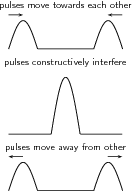| << Chapter < Page | Chapter >> Page > |
Let us now consider what happens to a pulse when it reaches the end of a medium. The medium can be fixed, like a rope tied to a wall, or it can be free, like a rope tied loosely to a pole.
Tie a rope to a wall or some other object that cannot move. Create a pulse in the rope by flicking one end up and down. Observe what happens to the pulse when it reaches the wall.

When the end of the medium is fixed, for example a rope tied to a wall, a pulse reflects from the fixed end, but the pulse is inverted (i.e. it is upside-down). This is shown in [link] .
Tie a rope to a pole in such a way that the rope can move up and down the pole. Create a pulse in the rope by flicking one end up and down. Observe what happens to the pulse when it reaches the pole.
When the end of the medium is free, for example a rope tied loosely to a pole, a pulse reflects from the free end, but the pulse is not inverted . This is shown in [link] . We draw the free end as a ring around the pole. The ring will move up and down the pole, while the pulse is reflected away from the pole.

The following simulation will help you understand the previous examples. Choose pulse from the options (either manual, oscillate or pulse). Then click on pulse and see what happens. Change from a fixed to a free end and see what happens. Try varying the width, amplitude, damping and tension.
Phet simulation for transverse pulses
Two or more pulses can pass through the same medium at that same time. The resulting pulse is obtained by using the principle of superposition . The principle of superposition states that the effect of the pulses is the sum of their individual effects. After pulses pass through each other, each pulse continues along its original direction of travel, and their original amplitudes remain unchanged.
Constructive interference takes place when two pulses meet each other to create a larger pulse. The amplitude of the resulting pulse is the sum of the amplitudes of the two initial pulses. This is shown in [link] .


Notification Switch
Would you like to follow the 'Siyavula textbooks: grade 10 physical science' conversation and receive update notifications?